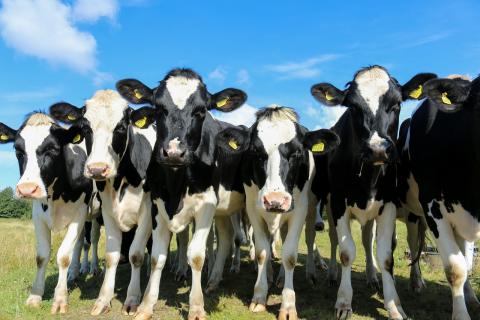Limit-Feeding Dairy Heifers

The concept of limit-feeding or precision feeding dairy heifers has been studied for the last decade primarily at Penn state and the University of Wisconsin. The goal of this research was to decrease costs while providing for adequate growth and performance after the heifer calves.
A few concepts regarding limit feeding and raising heifers are:
- Heifers are either the first or second largest cost on the dairy.
- Feed is the largest cost in raising heifers.
- Labor would be the second greatest cost in heifer raising.
An idea taken from the beef and other meat industries is the concept of feed efficiency. In other words, how much feed per unit gain. But differing from the meat industry is that we target growth at 1.8 to 2 pounds of gain per day over the post-weaned phase. Precision feeding allows the farmer to precisely balance the heifer’s diet with little wasted feed and a reduction in cost. There are no novel or different feed ingredients needed to make this work. However, there are some hard and fast methods that must be adhered to, to make this work on your farm.
How do you do this?
Birth to weaning- no changes from what is presently done on the farm.
Penn State recommends the following regarding nutrition and management.
Nutrition
General: No free choice forages or concentrates are fed. The diet must be followed specifically (Precision Feeding)
Dry matter intake (on a dry matter basis):
- Pre-puberty 2.15% body weight/day
- Post-puberty 1.65% body weight/ day
Crude protein:
- Pre-puberty 14-15%
- Post-puberty 13-14%
No RUP sources are needed here, this can be done with conventional ingredients.
Energy
The requirements are based on heifer size, growth rate, and environment the heifer is raised in.
Limit-feeding diets have a fixed energy requirement that meets an average daily gain of 1.75 to 2.0 pounds per day. This is equivalent to 130 kcal of metabolizable energy per pound of metabolic body weight (BW0.75). Work with your nutritionist or contact a UNH dairy specialist to help you with this if needed.
Fiber
Based on the fact that the heifers are limit fed, using poor quality forage (heifer hay) probably will not work here. Data suggests that NDF values as low as 19% can work in this situation, but typical NDF values range from 23 to 31% over the growth period.
Vitamins and minerals
There are no data indicating any changes required while limit feeding heifers
Concentrate sources
In this diet, a higher portion of the diet will be made of concentrate allowing the producer more flexibility in meeting nutrient requirements. It is important to meet the minimum NDF values, most of this will be from forage and help prevent any laminitis from happening. It is also suggested to limit the amount of alfalfa hay as this combination of a higher grain and alfalfa can result in frothy bloat.
Management
-
Heifers must be weighed often to ensure that heifers are gaining within the target gains of 1.75 to 2.0 pounds/day. For ease of weighing, anytime a heifer is handled, she should be weighed either via electronic scale or taped. Recent data indicates that dairy heifer weigh tapes are accurate. It is recommended that heifers be weighed monthly at the same time of day. These results will allow you to adjust the diets as the heifers grow.
-
Make sure all heifers can eat at the same time, no overcrowding because heifers will consume all their feed within an hour, headlocks work best to allow the heifers to eat without competing with a boss heifer. ALL heifers have to eat at one time.
-
Feed only once a day at the same time.
-
Grouping heifers should have a range of body weights less than 200 pounds within a pen after 4 months of age (2-4 month age variation at the most within a pen).
-
No straw or shavings as bedding- they will eat it.
-
Expect a lot of vocalization at the start, they will settle down eventually.
-
When heifers are approaching freshening (two months prior to calving), you can add them to the high forage dry cow pen. Their rumens will adjust.
Experience at UNH
We have been limit feeding post-weaned heifers for a few years now. What we see is adequate growth, no feed wastage, and no negative effects on performance or breeding. Routinely, our age at first calving is 22 months. If you are interested in limit feeding don’t hesitate to contact me or work with your nutritionist. You should see adequate growth, lower feed costs and lower labor costs.
Reference: PennState Extension - Precision feeding dairy heifers: Strategies and Recommendations.
